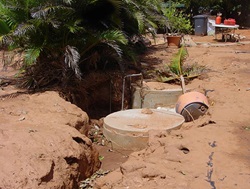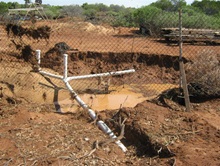Flood damaged on site wastewater systems
Floodwaters or heavy rain may damage your septic tank, which is also known as an onsite wastewater system.
Floodwater may enter your septic tank system through the toilet, other fixtures or the overflow relief gully grate.
Flooding of the septic system may wash solids out from the tank, causing blockages or system damage.
If wastewater has overflowed into the home read domestic wastewater overflows for information on how to clean-up.

Checking for damage
- open the septic system cover/pit.
- Check the leaking system (including pipes).
- Check for damaged/exposed pipes that need capping or sealing.
Failed septic systems are not easy to identify but signs include:
- a strong odour around the tank and surrounding area
- blocked plumbing, with wastewater overflowing on the ground
- high level of sludge close to the outlet and inlet pipes in the primary tank
- sewage flowing up through the toilet and sinks.
Damaged septic tank
Do not use any toilets, laundry, kitchen or bathroom sinks or whitegoods that are connected to the damaged septic
system until:
- all parts of the septic system have been professionally inspected and repaired
- your onsite wastewater disposal system has been approved for use by the local government environmental health
officer.
Some onsite wastewater treatments systems rely on equipment such as pumps, aerators and filters. This equipment may be damaged by floodwater or loss of power. To prevent further damage to your system, contact a wastewater service technical – your local government can provide you with a list of authorised personnel.
Cleaning or pumping out a flooded septic tank should be done with care as this could cause the tank to float out of
the ground and damage the structure and pipes.
After a septic tank is pumped out, it should be filled with water to prevent it from floating out of the ground.
Fixing a damaged septic tank

Only trained specialists can clean, repair or pump onsite septic systems because septic tanks may contain dangerous
gases and other harmful materials.
As soon as possible after flooding, when there is no visible water on the surface of the ground, arrange for a
licensed septic tank operator to pump out your onsite septic system.
Contact your local government environmental health officer for a list of septic (wastewater disposal) system
contractors who work in your area.
Aerated wastewater treatment system
Do not use an aerated wastewater treatment system (AWTS) that has been flooded.
Isolate the electrical connection and call a wastewater service technician immediately to fix or replace the system.
Last reviewed: 20-10-2023
Acknowledgements
Environmental Health Directorate
This publication is provided for education and information purposes only. It is not a substitute for professional advice. Information about a service, product or treatment does not imply endorsement and is not intended to replace professional advice. Readers should note that over time currency and completeness of the information may change. All users should seek advice from a qualified professional for answers to their questions.